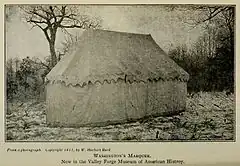
General George Washington used a pair of campaign tents throughout much of the American Revolutionary War. In warm weather, he used one for dining with his officers and aides, and the other as his military office and sleeping quarters. Canvas panels and poles from both tents survive, and are currently owned by four separate historical organizations.[1]
Revolutionary War
Washington's headquarters staff consisted of his military secretary and (usually) four aides-de-camp. The office tent was their workplace, where they managed the commander-in-chief's correspondence and made copies of his orders. A divided section of the tent was where Washington slept. His enslaved valet William Lee also slept there.[2] The dining tent was used for meals. Washington's first pair of campaign tents were made by Philadelphia upholsterer Plunket Fleeson in Spring 1776.[1] They were used at the first Middlebrook encampment in 1777 and in Washington Valley near Middlebrook, New Jersey:
The Army is now drawn together at this place, at least that part of it, which have been Cantoned all Winter in this state. The whole of them now Encamped in Comfortable Tents on a Valley covered in front and rear by ridges which affords us security. His excellency our good Old General, has also spread his Tent, and lives amongst us.[3]
The first pair of tents were used until the end of the 1777–78 winter encampment at Valley Forge.[1] New tents were ordered by Deputy Quartermaster General James Abeel in June 1778, but the maker was not identified.[4]
There were two marquées attached to the headquarters during all the campaigns. The larger, or banqueting tent, would contain from forty to fifty persons; the smaller, or sleeping tent, had an inner-chamber, where, on a hard cot-bed, the chief reposed. Within its venerable folds, Washington was in the habit of seeking privacy and seclusion, where he could commune with himself, and where he wrote the most memorable of his despatches in the Revolutionary war.[5]
In 2017, Philip Mead, chief historian at the Museum of the American Revolution in Philadelphia, and museum curators determined that a panoramic watercolor painting by Pierre Charles L'Enfant was of the 1782 encampment at Verplanck's Point and depicted the office and sleeping tent in field use.[6]
Civil War
The panels and poles from both tents were inherited by Martha Washington's grandson, George Washington Parke Custis. He passed them on to his daughter, Mary Anna Custis Lee, and her husband, Robert E. Lee. Their enslaved housekeeper, Selina Norris Gray, kept the tent fabric safe when Union Army soldiers ransacked Arlington House during the American Civil War.[2]
The tents were among the Washington artifacts seized by the federal government in January 1862,[1] and the grounds of Arlington House were converted into Arlington National Cemetery.
Later history
The tents were exhibited at the U.S. Patent Office, and transferred to the Smithsonian Institution in 1881.[1] It wasn't until 1901, nearly 40 years after their seizure, that the tents and Washington artifacts were returned to the Lees' son, George Washington Custis Lee.[1][7] In 1906, Robert E. Lee's daughter Mary Custis Lee donated George Washington's military tents for a benefit sale to raise funds for the Home for Needy Confederate Women in Richmond.[7]
In 1909, the exterior of the office/sleeping tent was purchased by Reverend Dr. W. Herbert Burk for the Valley Forge Museum of American History, predecessor to the Valley Forge Historical Society. It was exhibited in a museum on the grounds of the 1777–1778 Valley Forge encampment.[8]
Current locations

Pieces of the tents are currently owned by four different historical organizations:
- Colonial National Historical Park owns the interior of the dining tent roof, the office/sleeping tent interior, and the poles of the office/sleeping tent. All of these items are currently on display at the Yorktown Battlefield Visitor Center.
- The Mount Vernon Ladies' Association owns the linen door to the office/sleeping tent.
- The Museum of the American Revolution in Philadelphia owns the exterior of the office/sleeping tent, poles of the dining tent, and a storage trunk.[9] Sometimes described as the first "Oval Office",[10] the tent is exhibited at the new Museum of the American Revolution, opened April 19, 2017.[11]
See also
References
- 1 2 3 4 5 6 Marshall, Andrea. "George Washington's Marquee Tent". George Washington's Mount Vernon. Retrieved 15 February 2017.
- 1 2 Kahn, Eve (25 August 2016). "George Washington Really Slept Here. So Did His Slave". New York Times. Retrieved 29 August 2016.
- ↑ Washington, George (May 29, 1777). "General Orders". Founders Online. National Archives. Footnote 1 has an excerpt from a letter from Gen. George Weedon to John Page dated May 31, 1777.
- ↑ George Washington Slept Here, from Valley Forge National Historical Park.
- ↑ George Washington Parke Custis, Recollections and Private Memoirs of Washington, (New York: Derby & Jackson, 1860), p. 279.
- ↑ Schuessler, Jennifer (November 15, 2017). "Washington's Tent: A Detective Story. How the Museum of the American Revolution found the only known depiction of George Washington's traveling headquarters during the Revolutionary War". The New York Times.
- 1 2 Boettcher, Hannah (May 23, 2016). Mary Custis Lee unpacks the Washington relics: a revolutionary inheritance in museums, 1901-1918 (Thesis). University of Delaware – via udspace.udel.edu.
- ↑ "Museum of the American Revolution enters the home stretch".
- ↑ "George Washington Slept Here". Valley Forge National Historical Park. NPS. Retrieved 15 February 2017.
 This article incorporates text from this source, which is in the public domain.
This article incorporates text from this source, which is in the public domain. - ↑ "The First "Oval Office"". Museum of The American Revolution. Retrieved 15 February 2017.
- ↑ Crimmins, Peter (3 December 2013). "Museum stages dress rehearsal for Gen. George Washington's tent". WHYY-FM. Retrieved 29 August 2016.
External links
- Historic American Buildings Survey (HABS) No. PA-6713, "George Washington's 1776 Sleeping Marquee, Valley Forge, Chester County, PA", 8 measured drawings